The Intel Core i9-9980XE CPU Review: Refresh Until it Hertz
by Ian Cutress on November 13, 2018 9:00 AM ESTHEDT Performance: Web and Legacy Tests
While more the focus of low-end and small form factor systems, web-based benchmarks are notoriously difficult to standardize. Modern web browsers are frequently updated, with no recourse to disable those updates, and as such there is difficulty in keeping a common platform. The fast paced nature of browser development means that version numbers (and performance) can change from week to week. Despite this, web tests are often a good measure of user experience: a lot of what most office work is today revolves around web applications, particularly email and office apps, but also interfaces and development environments. Our web tests include some of the industry standard tests, as well as a few popular but older tests.
We have also included our legacy benchmarks in this section, representing a stack of older code for popular benchmarks.
All of our benchmark results can also be found in our benchmark engine, Bench.
WebXPRT 3: Modern Real-World Web Tasks, including AI
The company behind the XPRT test suites, Principled Technologies, has recently released the latest web-test, and rather than attach a year to the name have just called it ‘3’. This latest test (as we started the suite) has built upon and developed the ethos of previous tests: user interaction, office compute, graph generation, list sorting, HTML5, image manipulation, and even goes as far as some AI testing.
For our benchmark, we run the standard test which goes through the benchmark list seven times and provides a final result. We run this standard test four times, and take an average.
Users can access the WebXPRT test at http://principledtechnologies.com/benchmarkxprt/webxprt/
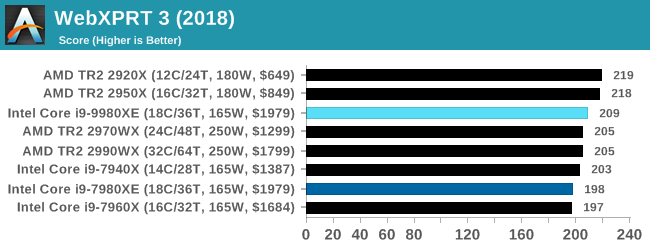
WebXPRT 2015: HTML5 and Javascript Web UX Testing
The older version of WebXPRT is the 2015 edition, which focuses on a slightly different set of web technologies and frameworks that are in use today. This is still a relevant test, especially for users interacting with not-the-latest web applications in the market, of which there are a lot. Web framework development is often very quick but with high turnover, meaning that frameworks are quickly developed, built-upon, used, and then developers move on to the next, and adjusting an application to a new framework is a difficult arduous task, especially with rapid development cycles. This leaves a lot of applications as ‘fixed-in-time’, and relevant to user experience for many years.
Similar to WebXPRT3, the main benchmark is a sectional run repeated seven times, with a final score. We repeat the whole thing four times, and average those final scores.
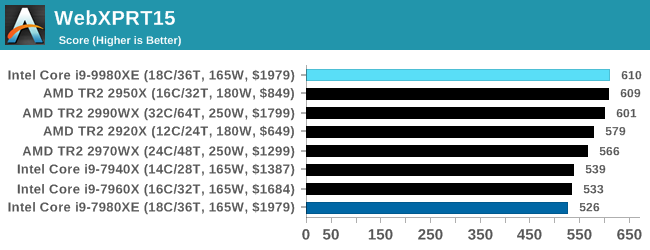
Speedometer 2: JavaScript Frameworks
Our newest web test is Speedometer 2, which is a accrued test over a series of javascript frameworks to do three simple things: built a list, enable each item in the list, and remove the list. All the frameworks implement the same visual cues, but obviously apply them from different coding angles.
Our test goes through the list of frameworks, and produces a final score indicative of ‘rpm’, one of the benchmarks internal metrics. We report this final score.
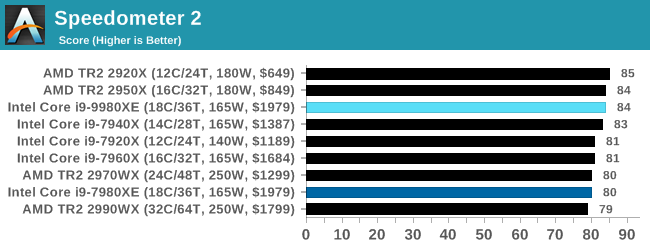
Google Octane 2.0: Core Web Compute
A popular web test for several years, but now no longer being updated, is Octane, developed by Google. Version 2.0 of the test performs the best part of two-dozen compute related tasks, such as regular expressions, cryptography, ray tracing, emulation, and Navier-Stokes physics calculations.
The test gives each sub-test a score and produces a geometric mean of the set as a final result. We run the full benchmark four times, and average the final results.
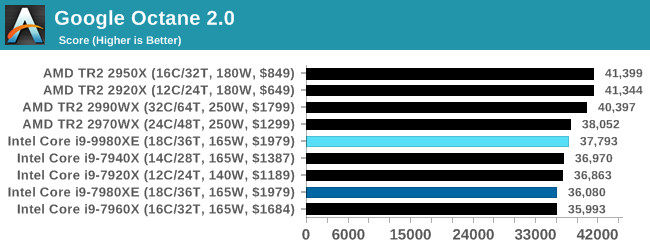
Mozilla Kraken 1.1: Core Web Compute
Even older than Octane is Kraken, this time developed by Mozilla. This is an older test that does similar computational mechanics, such as audio processing or image filtering. Kraken seems to produce a highly variable result depending on the browser version, as it is a test that is keenly optimized for.
The main benchmark runs through each of the sub-tests ten times and produces an average time to completion for each loop, given in milliseconds. We run the full benchmark four times and take an average of the time taken.

3DPM v1: Naïve Code Variant of 3DPM v2.1
The first legacy test in the suite is the first version of our 3DPM benchmark. This is the ultimate naïve version of the code, as if it was written by scientist with no knowledge of how computer hardware, compilers, or optimization works (which in fact, it was at the start). This represents a large body of scientific simulation out in the wild, where getting the answer is more important than it being fast (getting a result in 4 days is acceptable if it’s correct, rather than sending someone away for a year to learn to code and getting the result in 5 minutes).
In this version, the only real optimization was in the compiler flags (-O2, -fp:fast), compiling it in release mode, and enabling OpenMP in the main compute loops. The loops were not configured for function size, and one of the key slowdowns is false sharing in the cache. It also has long dependency chains based on the random number generation, which leads to relatively poor performance on specific compute microarchitectures.
3DPM v1 can be downloaded with our 3DPM v2 code here: 3DPMv2.1.rar (13.0 MB)
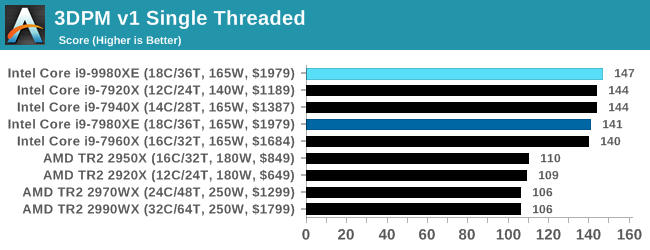
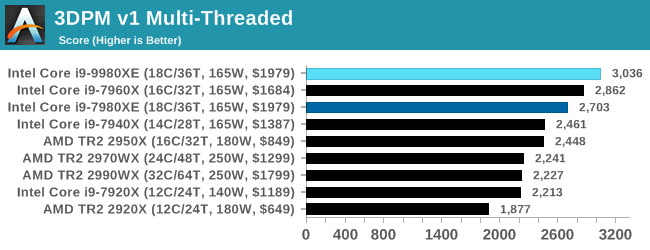
x264 HD 3.0: Older Transcode Test
This transcoding test is super old, and was used by Anand back in the day of Pentium 4 and Athlon II processors. Here a standardized 720p video is transcoded with a two-pass conversion, with the benchmark showing the frames-per-second of each pass. This benchmark is single-threaded, and between some micro-architectures we seem to actually hit an instructions-per-clock wall.
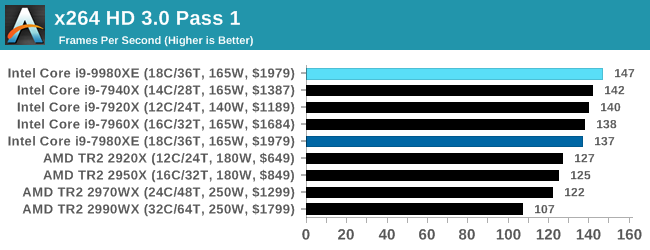
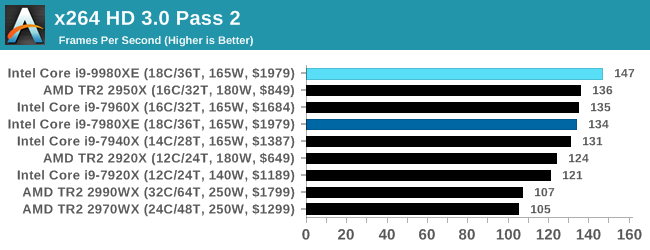










143 Comments
View All Comments
Cellar Door - Tuesday, November 13, 2018 - link
The best part is that an i7 part(9800X) is more expensive then a i9 part(9900k). Intel smoking some good stuff.DigitalFreak - Tuesday, November 13, 2018 - link
You're paying more for those extra 28 PCI-E lanesHixbot - Tuesday, November 13, 2018 - link
And much more L3. It's also interesting that HEDT is no longer behind in process node.Hixbot - Tuesday, November 13, 2018 - link
And AVX512eastcoast_pete - Tuesday, November 13, 2018 - link
@Ian: Thanks, good overview and review!Agree on the "iteration when an evolutionary upgrade was needed"; it seems that Intel's development was a lot more affected by its blocked/constipated transition to 10 nm (now scrapped), and the company's attention was also diverted by its forays into mobile (didn't work out so great) and looking for progress elsewhere (Altera acquisition). This current "upgrade" is mainly good for extra PCI-e lanes (nice to have more), but it's performance is no better than the previous generation. If the new generation chips from AMD are halfway as good as they promise, Intel will loose a lot more profitable ground in the server and HEDT space to AMD.
@Ian, and all: While Intel goes on about their improved FinFet 14 nm being the reason for better performance/Wh, I wonder how big the influence of better heat removal through the (finally again) soldered heat spreader is? Yes, most of us like to improve cooling to be able to overclock more aggressively, but shouldn't better cooling also improve the overall efficiency of the processor? After all, semiconductors conduct more current as they get hotter, leading to ever more heat and eventual "gate crashing". Have you or anybody else looked at performance/Wh between, for example, an i7 8700 with stock cooler and pasty glued heat spreader vs. the same processor with proper delidding, liquid metal replacement and a great aftermarket cooler, both at stock frequencies? I'd expect the better cooled setup to have more performance/Wh, but is that the case?
Arbie - Tuesday, November 13, 2018 - link
The "Competition" chart is already ghastly for Intel. Imagine how much worse it will be when AMD moves to 7 nm with Zen 2.zepi - Tuesday, November 13, 2018 - link
How about including some kind of DB test?I think quite a few people are looking at these workstation class CPU's to develop BI things and it might quite helpful to actually measure results with some SQL / NoSQL / BI-suites. Assuming bit more complex parallel SQL executions with locking could show some interesting differences between NUMA-Threadrippers and Intels.
GreenReaper - Wednesday, November 14, 2018 - link
It's a good idea, Phoronix does them so in the short term you could probably look there.jospoortvliet - Friday, November 16, 2018 - link
But then make sure it is realistic, not running in cache or such... A real db suitable for these chips is terabytes, merely keeping the index in ram... rule of thumb: if your index fits in cache your database doesn't need this CPU ;-)FunBunny2 - Tuesday, November 13, 2018 - link
I guess I can run my weather simulation in Excel on my personal machine now. neato.